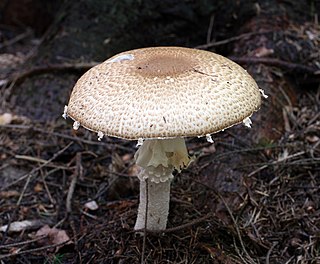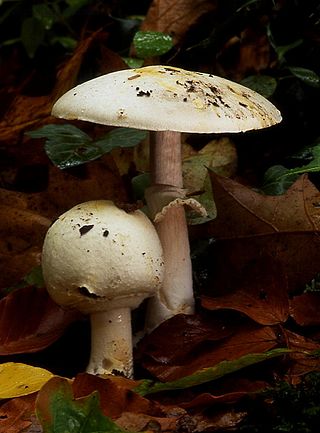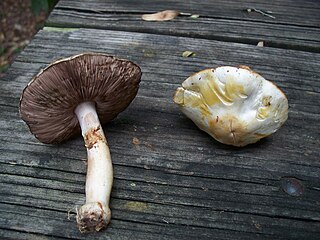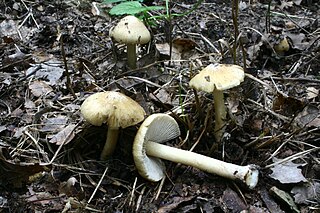
Agaricus is a genus of mushroom-forming fungi containing both edible and poisonous species, with over 400 members worldwide and possibly again as many disputed or newly-discovered species. The genus includes the common ("button") mushroom and the field mushroom, the dominant cultivated mushrooms of the West.

Tricholoma pardinum, commonly known as spotted tricholoma, tiger tricholoma, tigertop, leopard knight, or dirty trich, is a gilled mushroom widely distributed across North America, Europe, and parts of Asia. It is generally found in beech woodland in summer and autumn. Two subspecies have been described from southern Europe. First officially described by Christiaan Hendrik Persoon in 1801, T. pardinum has had a confusing taxonomic history that extends over two centuries. In 1762, German naturalist Jacob Christian Schäffer described the species Agaricus tigrinus with an illustration corresponding to what is thought to be T. pardinum, and consequently, the name Tricholoma tigrinum has been used erroneously in some European field guides.

Agaricus augustus, known commonly as the prince, is a basidiomycete fungus of the genus Agaricus.

Agaricus bernardii, commonly called the salt-loving agaricus, or salty mushroom, is an agaric fungus in the family Agaricaceae. The mushroom's thick stem is usually shorter than the diameter of the cap, which ranges from 5–15 centimetres and is convex to flattened. The cap surface is whitish to buff, and can develop scales or warts in age. The gills are initially pink before turning brown when the spores mature. The flesh turns reddish when it is cut or bruised. It resembles species such as A. bitorquis.

Agaricus silvicola, also known as the wood mushroom or woodland agaricus, is a species of Agaricus mushroom related to the button mushroom. A. silvicola is a member of Agaricus section Arvenses, a group of morphologically similar mushrooms. A. silvicola, like other species in Agaricus section Arvenses, exhibits a positive Schäffer's reaction and potassium hydroxide reaction, and smells of almonds or anise.

Inocybe geophylla, commonly known as the earthy inocybe, common white inocybe or white fibercap, is a poisonous mushroom of the genus Inocybe. It is widespread and common in Europe and North America, appearing under both conifer and deciduous trees in summer and autumn. The fruiting body is a small all-white or cream mushroom with a fibrous silky umbonate cap and adnexed gills. An all-lilac variety lilacina is also common.

Agaricus abruptibulbus is a species of mushroom in the genus Agaricus. It is commonly known as the abruptly-bulbous agaricus or the flat-bulb mushroom. First described by the mycologist Charles Horton Peck, this bulbous-stemmed edible species smells slightly of anise or bitter almond, and turns yellow when bruised or cut. The mushroom is medium-sized, with a white, yellow-staining cap on a slender stipe that has a wide, flat bulb on the base.

Cortinarius mucosus, commonly known as the orange webcap or the slimy cortinarius, is a species of mushroom in the family Cortinariaceae. In North America, the species is more commonly associated with northern coniferous forests. The specific epithet is derived from the Latin word mucosus, meaning mucus.

Agaricus lilaceps, also known as the cypress agaricus or the giant cypress agaricus is a species of mushroom. It is among the largest and most choice edible Agaricus species in California. Aside from size, Agaricus lilaceps is characterized by a robust stature, as the stipe often club-shaped.

Agaricus placomyces is a toxic basidiomycete fungus of the genus Agaricus. It is found in North America; the Eurasian populations formerly known by the same scientific name are nowadays known as A. moelleri, while the present species may also be referred to as A. praeclaresquamosus.

Agaricus arorae is a moderate-sized, forest-dwelling mushroom that exhibits distinctive color changes. It fruits early in the mushroom season. Unusually within the genus Agaricus, the mushroom's cap cuticle turns yellow when exposed to a base such as potassium hydroxide or sodium hydroxide but stains red when cut. In the field, it has a brownish, fibrillose/squamulose cap, which turns red when bruised. Agaricus arorae was first described from Santa Cruz County but since has been found in San Mateo and Alameda counties. Agaricus arorae can be distinguished by its scales and a conspicuous stipe.

Agaricus albolutescens, commonly known as the amber-staining agaricus, is a moderate-sized, stocky-statured mushroom with a pleasant odor; it bruises slowly but persistently yellow.

Agaricus perobscurus, commonly known collectively with its close European relative Agaricus lanipes as the princess, is a basidiomycete fungus. A relative of Agaricus augustus, known as the prince, A. perobscurus can be differentiated in several aspects. While the prince is widely distributed in North America, the princess is found only in the San Francisco Bay Area. Besides its smaller size, it is distinguished from Agaricus augustus by a darker-brown cap, a patchy fibrillose stipe surface at youth, lacking densely floccose-scaly, and a different fruiting season. Another commonly closely associated Agaricus species, Agaricus praeclaresquamosus, is toxic. It can be differentiated by its dark-grey cap, a phenolic, rather than an anise odor, and a stipe base which yellows immediately when injured.

Agaricus dulcidulus is a small mushroom in the family Agaricaceae of the order Agaricales, found in deciduous woodlands of Europe, but also recorded in North America, North Africa and Asia. The English name is rosy wood mushroom. Despite the tendency of some sources to synonymize it with Agaricus semotus, this is a distinct taxon.

Agaricus deserticola, commonly known as the gasteroid agaricus, is a species of fungus in the family Agaricaceae. Found only in southwestern and western North America, A. deserticola is adapted for growth in dry or semi-arid habitats. The fruit bodies are secotioid, meaning the spores are not forcibly discharged, and the cap does not fully expand. Unlike other Agaricus species, A. deserticola does not develop true gills, but rather a convoluted and networked system of spore-producing tissue called a gleba. When the partial veil breaks or pulls away from the stem or the cap splits radially, the blackish-brown gleba is exposed, which allows the spores to be dispersed.

Inosperma cookei, commonly known as the straw fibrecap, is a species of mushroom in the family Inocybaceae. It was first described in 1892 by Giacomo Bresadola, and is named in honour of Mordecai Cubitt Cooke. The species is found in Europe, Asia, and North America. It produces small mushrooms of an ochre colour, with a prominent umbo, fibres on the cap and a distinctive bulb at the base of the stem. It grows from soil in mixed woodland, and is encountered in summer and autumn, though is not common. Ecologically, it feeds through use of ectomycorrhiza. Inosperma cookei has been described as both toxic and non-toxic, but either way, is not advised for consumption.

Agaricus hondensis, commonly known as the felt-ringed agaricus, is a species of fungus in the family Agaricaceae. The species was officially described in 1912 by mycologist William Alphonso Murrill, along with three other Agaricus species that have since been placed in synonymy with A. hondensis. Found in the Pacific Northwest region of North America, A. hondensis fruits in the fall under conifers or in mixed forests.

Hygrophorus purpurascens, commonly known as the purple-red waxy cap, is a species of agaric fungus in the family Hygrophoraceae. Its cap has a pink background color with streaks of purplish red overlaid, and mature gills have red spots.

Hygrophorus hypothejus, commonly known as the olive-brown waxy cap, or herald of the winter, is an edible species of fungus in the genus Hygrophorus native to Europe. It appears in late autumn in coniferous forests, often with the first frosts.

Inocybe godeyi is a species of Inocybaceae fungus found in Europe. The species produces mushrooms with cone-shaped caps up to 5 cm (2 in) in diameter. The caps are cream, becoming browner, but they bruise red. The stem is up to 6 cm (2 in) long, and has a "bulb" at the base. The white flesh has a strong smell and an acrid taste. The mushrooms can be found on forest floors in autumn months; the species forms an ectomycorrhizal relationship to surrounding trees, favouring beech. I. godeyi is known to be poisonous, containing muscarine compounds, and consumption of the mushrooms can lead to SLUDGE syndrome. The species is sometimes mistaken for the deadly I. erubescens.





















